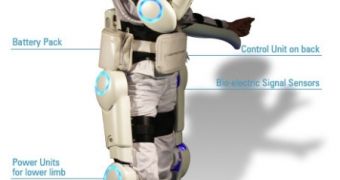The Japanese manufacturer of the full-body robotics system says that HAL (Hybrid Assistive Limb) is a platform designed to boost the strength of the wearer between 2 and 10 times, via the use of incorporated sensors that can detect the electrical impulses the brain sends to the limbs in order to make them move. These impulses are intercepted and analyzed in real time, prompting the device to move with the wearer, thus avoiding the system hindering the person it's assisting.
In addition to this type of sensors, which can receive conflicting signals from multiple muscle layers, and can jam, Cyberdyne turned to electronics giant Honda, which came up with a rather ingenious solution – sensors in the exoskeleton will track the faintest movements of the limbs and attempt to match the speed of the device with those movements.
The manufacturers say that the system is very similar to that employed in cars, known as power steering. The movements of the wheels are interpreted by a sophisticated mechanism, and its turns are translated into turns of the wheels through the use of servo engines, which make the driver's ride a lot easier. The person behind the wheel doesn't have to steer that hard to get the same result, thus remaining more calm and focused on the road.
On Cyberdyne's website, the product is advertised as having a voluntary control system, as well as a robotic autonomous control system, which work together to ensure that the exoskeleton takes the largest part of the effort the wearer puts out to move, while at the same time ensuring a smooth, human-like motion, as opposed to the jolted ones that can be felt when using other similar systems.
HAL possesses aid devices for both arms and legs, and can even support the lower part of the spinal cord, thus making it a prospect to track over the years. As soon as the technology is perfect, Cyberdyne plans to make it commercially available for accessible fees. It could be used by old or otherwise incapacitated people, and it's said to be able to help them perform daily tasks, such as climbing stairs, walking, standing, lifting and so on.

 14 DAY TRIAL //
14 DAY TRIAL //